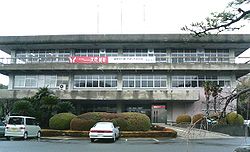Hikari, Yamaguchi
Hikari .mw-parser-output .noboldfont-weight:normal 光市 | |||
|---|---|---|---|
City | |||
 Hikari city office | |||
| |||
 Location of Hikari in Yamaguchi Prefecture | |||
 Hikari Location in Japan | |||
| Coordinates: 33°57′43″N 131°56′32″E / 33.96194°N 131.94222°E / 33.96194; 131.94222Coordinates: 33°57′43″N 131°56′32″E / 33.96194°N 131.94222°E / 33.96194; 131.94222 | |||
| Country | Japan | ||
| Region | Chūgoku (San'yō) | ||
| Prefecture | Yamaguchi Prefecture | ||
| Government | |||
| • Mayor | Yasuyoshi Sueoka | ||
| Area | |||
| • Total | 91.94 km2 (35.50 sq mi) | ||
| Population (October 1, 2016) | |||
| • Total | 51,040 | ||
| • Density | 560/km2 (1,400/sq mi) | ||
| Symbols | |||
| • Tree | Japanese Black Pine | ||
| • Flower | Ume | ||
| Time zone | UTC+9 (JST) | ||
| City hall address | 6-1-1 Chūō, Hikari-shi, Yamaguchi-ken 743-8501 | ||
| Website | www.city.hikari.yamaguchi.jp | ||
Hikari (光市, Hikari-shi) is a city located in Yamaguchi Prefecture, Japan.
The city was founded three times[dubious ]: April 1, 1943, July 1, 1955, and October 4, 2004.
As of October 1, 2016, the city has an estimated population of 51,040, and a population density 560 of persons per km². The total area is 91.94 km². The name Hikari itself means "brilliance" or "light" in Japanese.
It is connected by railroad with a train station and route 188.
Hikari is bounded with Yanai, Kudamatsu, Shunan, Iwakuni and Tabuse in the Kumage District.
On October 4, 2004, the town of Yamato (from Kumage District) was merged into Hikari.
Contents
1 History
1.1 Municipal timeline
1.2 Military
2 References
3 External links
History
Municipal timeline
- October 1, 1940: The town of Shunan was renamed to Hikari.
- April 1, 1943: The town merged with the town of Murozumi to form the city of Hikari (1st generation).
- July 1, 1955: The city (1st generation) merged with the village of Suō to form the new city of Hikari (2nd generation).
- April 10, 1957: The city lost parts of Tateno area to the village of Yamato.
- October 4, 2004: The city (2nd generation) absorbed the town of Yamato (from Kumage District) to create the new and expanded city of Hikari (3rd generation).
Military
The Hikari Naval Arsenal (or Dockyard) included a fire-control factory, built in 1942, that employed about 600 people. It was one of the principal establishments for producing the Standard H.A. System (Type 94 Kosha Sochi) at the rate of ~15 per month, along with bomb components, torpedo afterbodies, and misc. machined parts.[1]
The Imperial Japanese Navy formed the Second Special Attack Force (former First Special Base Unit) on March 1, 1945, at Hikari for conducting kaiten attacks. Rear Admiral Nagai Mitsuru was the Commanding Officer. On that same day, a kaiten crew training unit is also formed at Hirao, SE of Hikari.[2]
This was one of four such kaiten training bases.
With hints of cessation of hostilities, bombing raids by U.S. forces were canceled. However, resumption of bombing was ordered on August 13, 1945.[3]
The Hikari Naval Arsenal was consequently bombed the next day on August 14, 1945 (one day before the end of war), taking 738 lives.[2][4]
The attacking U.S. aircraft were 156 B-29 bombers[5] of the 40th Bomb Group[6]
stationed in Saipan, supported by P-51 Mustangs from Iwo Jima.[2]
The 40th Bomb Group dropped 3,540 bombs (885 tons) on the Hikari Naval Arsenal, resulting in severe destruction.[7][8]
Including this bombing, Hikari lost more than 1,200 citizens in World War II, both military and civilian.[4]
After surrender, Allied forces found 52 kaiten at Hikari and destroyed them.[2]
The former Hikari Naval Arsenal is now the sites for Nippon Steel Corporation
[5] and vaccine manufacturing by Takeda Pharmaceutical Company.[9]
Takeda discovered the hull of a Type 4 Kaiten under one of the buildings in August 1989, an attestation to the history of the site.[2]
The Kaiten Monument, erected in 1996, honors Hikari Naval Arsenal kaiten pilots. Steel frames that once constituted the structure of the destroyed Hikari Naval Arsenal were used to build the Tsukumo Bridge.[10]
References
^ Jackson, D.H, and Delmar-Morgan, S. "JAPANESE ORDNANCE RESEARCH TESTING, AND TRAINING" (United States Navy, January 1946) Part II.B, p. 9 - accessed 28 Jan 2010
^ abcde Hackett, Bob and Kingsepp, Sander. "SENSUIKAN! Midget Submarines in Japan and 'Operation Downfall' - 1945" - accessed 28 Jan 2010
^ Dorr, Robert F. "B-29 Superfortress Units of World War 2" (Osprey Publishing, 2002) p. 77 - accessed 28 Jan 2010
^ ab Tomokiyo, Hiroshi. "2005 Hikari City Memorial Service for the War Dead" - accessed 27 Jan 2010
^ ab Tomokiyo, Hiroshi. "2004 Hikari City Memorial Service for the War Dead" - accessed 27 Jan 2010
^ Wyatt, Daniel. "World War II: 40th Bomb Group" (Aviation History, September 1994) - accessed 28 Jan 2010
^ "MISSION SUMMARIES: Mission # 325" - accessed 28 Jan 2010
^ "Army Air Forces Statistical Digest, World War II" (The United States Army Air Forces in World War II) Table 201 - accessed 28 Jan 2010
^ Takeda Pharmaceutical Company Limited. "History 1945-1984" - accessed 27 Jan 2010
^ Tomokiyo, Hiroshi. "The Hikari Naval Dockyard" - accessed 27 Jan 2010
External links
| Wikimedia Commons has media related to Hikari, Yamaguchi. |
Official website (in Japanese)

